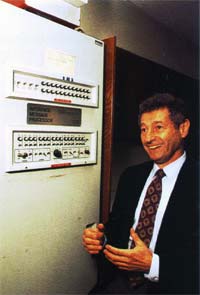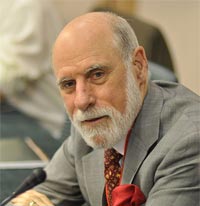Who invented the Internet?
A single person did not create the Internet that we know and use today. Below is a listing of different people who have helped contribute to and develop the Internet.
The idea
The initial idea of the Internet is credited to Leonard Kleinrock after he published his first paper entitled "Information Flow in Large Communication Nets" on May 31, 1961.
In 1962, J.C.R. Licklider became the first Director of IPTO and gave his vision of a galactic network. Also, with ideas from Licklider and Kleinrock, Robert Taylor helped create the idea of the network that later became ARPANET.
Initial creation
The Internet as we know it today first started being developed in the late 1960's in California in the United States.
In the summer of 1968, the Network Working Group (NWG) held its first meeting, chaired by Elmer Shapiro, at the Stanford Research Institute (SRI). Other attendees included Steve Carr, Steve Crocker, Jeff Rulifson, and Ron Stoughton. In the meeting, the group discussed solving issues related to getting hosts to communicate with each other.
In December 1968, Elmer Shapiro with SRI released a report "A Study of Computer Network Design Parameters." Based on this work and earlier work done by Paul Baran,Thomas Marill and others, Lawrence Roberts and Barry Wessler created the Interface Message Processor (IMP) specifications. Bolt Beranek and Newman, Inc. (BBN) was later awarded the contract to design and build the IMP subnetwork.
General public learns about Internet
The UCLA (University of California, Los Angeles) put out a press release introducing the public to the Internet on July 3, 1969.
First network equipment
 On August 29, 1969, the first network switch and the first piece of network equipment called "IMP" (Interface Message Processor) is sent to UCLA.
On August 29, 1969, the first network switch and the first piece of network equipment called "IMP" (Interface Message Processor) is sent to UCLA.
On September 2, 1969, the first data moves from the UCLA host to the switch. The picture to the right is Leonard Kleinrock next to the IMP.
The first message and network crash
On Friday October 29, 1969 at 10:30 p.m., the first Internet message was sent from computer science Professor Leonard KleinRock's laboratory at UCLA, after the second piece of network equipment was installed at SRI. The connection not only enabled the first transmission to be made, but is also considered the first Internetbackbone.
The first message to be distributed was "LO", which was an attempt at "LOGIN" byCharley S. Kline to log into the SRI computer from UCLA. However, the message was unable to be completed because the SRI system crashed. Shortly after the crash, the issue was resolved, and he was able to log into the computer.

E-mail is developed
Ray Tomlinson sends the first network e-mail in 1971. It's the first messaging system to send messages across a network to other users.
TCP is developed
 Vinton Cerf and Robert Kahn design TCP during 1973 and later publish it with the help of Yogen Dalal and Carl Sunshinein December of 1974 in RFC 675. Most people consider these two people the inventors of the Internet.
Vinton Cerf and Robert Kahn design TCP during 1973 and later publish it with the help of Yogen Dalal and Carl Sunshinein December of 1974 in RFC 675. Most people consider these two people the inventors of the Internet.First commercial network
A commercial version of ARPANET, known as Telenet, is introduced in 1974 and considered to be the first Internet Service Provider (ISP).
Ethernet is conceived
The Modem is introduced
Dennis Hayes and Dale Heatherington released the 80-103A Modem in 1977. TheModem and their subsequent modems become a popular choice for home users to connect to the Internet and get online.
TCP/IP is created
In 1978, TCP splits into TCP/IP, driven by Danny Cohen, David Reed, and John Shochto support real-time traffic. The creation of TCP/IP help create UDP and is later standardized into ARPANET on January 1, 1983. Today TCP/IP is still the primary protocolused on the Internet.
DNS is introduced
Paul Mockapetris and Jon Postel introduce DNS in 1984, which also introduces thedomain name system. The first Internet domain name, symbolics.com, is registered on March 15, 1985 by Symbolics, a Massachusetts computer company.
First commercial dial-up ISP
The first commercial Internet Service Provider (ISP) in the US, known as "The World", is introduced in 1989. The World was the first ISP to be used on what we now consider to be the Internet.
HTML
 In 1990, Tim Berners-Lee develops HTML, which made a huge contribution to how we navigate and view the Internet today.
In 1990, Tim Berners-Lee develops HTML, which made a huge contribution to how we navigate and view the Internet today.WWW
Tim Berners-Lee introduces WWW to the public on August 6,1991. The World Wide Web (WWW) is what most people today consider the "Internet" or a series of sites and pages that are connected with links. The Internet had hundreds of people who helped develop the standards and technologies used today, but without the WWW, the Internet would not be as popular as it is today.
First graphical Internet browser
 Mosaic is the first widely used graphical World Wide Web browser developed and first released on April 22, 1993 by the NCSA with the help of Marc Andreessen and Eric Bina. A big competitor to Mosaic was Netscape, which was released a year later. Today, most of the Internet browsers we use today, e.g. Internet Explorer, Chrome, Firefox, etc., got their inspiration from the Mosaic browser.
Mosaic is the first widely used graphical World Wide Web browser developed and first released on April 22, 1993 by the NCSA with the help of Marc Andreessen and Eric Bina. A big competitor to Mosaic was Netscape, which was released a year later. Today, most of the Internet browsers we use today, e.g. Internet Explorer, Chrome, Firefox, etc., got their inspiration from the Mosaic browser.Java and JavaScript
Originally known as oak, Java is a programming language developed by James Goslingand others at Sun Microsystems. It was first introduced to the public in 1995 and today is widely used to create Internet applications and other software programs.
JavaScript was developed by Brendan Eich in 1995 and originally known asLiveScript. It was first introduced to the public with Netscape Navigator 2.0 and was renamed to JavaScript with the release of Netscape Navigator 2.0B3. JavaScript is aninterpreted client-side scripting language that allows a web designer the ability to insert code into their web page.

